Rio Grande do Sul
Template:Infobox Brazilian State
Rio Grande do Sul ( pron. IPA: [ʁiu 'gɾɐ̃.de do suɫ];[1] lit. "Great River of the South") is the southernmost state of Brazil, and the state with the fourth highest Human Development Index (HDI).[2]
Geography
Rio Grande do Sul is bordered to the north by the Brazilian state of Santa Catarina, to the east by the Atlantic Ocean, on the south by Uruguay, and to the west by Argentina.
The northern part of the state lies on the southern slopes of the elevated plateau extending southward from São Paulo across the states of Paraná and Santa Catarina, and is much broken by low mountain ranges whose general direction across the trend of the slope gives them the appearance of escarpments. A range of low mountains extends southward from the Serra do Mar of Santa Catarina and crosses the state into Uruguay. West of this range is a vast grassy plain devoted principally to stock-raising - the northern and most elevated part being suitable in pasturage and climate for sheep, and the southern for cattle. East of it is a wide coastal zone only slightly elevated above the sea; within it are two great estuarine lagoons, the Lagoa dos Patos and Lagoa Mirim, which are separated from the ocean by two sandy, partially barren peninsulas. The coast is one great sand beach, broken only by the outlet of the two lakes, called the Rio Grande, which affords an entrance to navigable inland waters and several ports. There are two distinct river systems in Rio Grande do Sul - that of the eastern slope draining to the lagoons, and that of the La Plata basin draining westward to the Uruguay River.
The larger rivers of the eastern group are the Jacuí, Sinos, Caí, Gravataí and Camacuã, which flow into the Lagoa dos Patos, and the Jaguarão which flows into the Lagoa Mirim. All of the first named, except the Camaquã, discharge into one of the two arms or estuaries opening into the northern end of Lagoa dos Patos, which is called the Guaíba River, though in reality it is not a river. The Guaíba River is broad, comparatively deep and about 35 miles long, and with the rivers discharging into it affords upwards of 200 miles of fluvial navigation. The Jacuí is one of the most important rivers of the state, rising in the ranges of the Coxilha (Cuchilla) Grande of the north and flowing south and southeast to the Guaíba estuary, with a course of nearly 300 miles It has two large tributaries, the Vacacaí from the south and the Taquari from the north, and many small streams. The Jaguarão, which forms part of the boundary line with Uruguay, is navigable 26 miles up to and beyond the town of Jaguarão.
In addition to the Lagoa dos Patos and Lagoa Mirim there are a number of small lakes on the sandy, swampy peninsulas that lie between the coast and these two, and there are others of a similar character along the northern coast. The largest lake is the Lagoa dos Patos (Lake of the Patos - an Indian tribe inhabiting its shores at the time of European discovery), which lies parallel with the coastline, northeast and southwest, and is about 133 miles long exclusive of the two arms at its northern end, 25 and 35 miles long respectively, and of its outlet, the Rio Grande, about 24 miles long. Its width varies from 22 to 36 miles. The lake is comparatively shallow and filled with sand banks, making its navigable channels tortuous and difficult. The Lagoa Mirim occupies a similar position farther south, on the Uruguayan border, and is about 108 miles long by 6 to 22 miles wide. It is more irregular in outline and discharges into Lagoa dos Patos through a navigable channel known as the São Gonçalo Channel.

A part of the lake lies in Uruguayan territory, but its navigation, as determined by treaty, belongs exclusively to Brazil. Both of these lakes are evidently the remains of an ancient depression in the coastline shut in by sand beaches built up by the combined action of wind and current. They are of the same level as the ocean, but their waters are affected by the tides and are brackish only a short distance above the Rio Grande outlet.
Fully one-third of the state belongs to the La Plata drainage basin. Of the many streams flowing northward and westward to the Uruguay, the largest are the Ijuí of the plateau region, the Ibicuí, which has its source near Santa Maria in the central part of the state and flows westward to the Uruguay a short distance above Uruguaiana, and the Quaraí River which forms part of the boundary line with Uruguay. The Uruguay River itself is formed by the confluence of the Canoas and Pelotas rivers. The Pelotas, which has its source in the Serra do Mar on the Atlantic coast, and the Uruguay River forms the northern and western boundary line of the state down to the mouth of the Quaraí, on the Uruguayan frontier.
Climate

Rio Grande lies within the south temperate zone and has a mild, temperate climate, except in the coastal zone where it is subtropical. There are only two well-marked seasons, though the transition periods between them (about two months each) are sometimes described as spring and autumn. The winter months, June to September, are characterized by heavy rains and by cold westerly winds, called minuanos, which sometimes lower the temperature to the freezing point, especially in the mountainous districts. Snow is very rare, but ice frequently forms on inland waters during cold winter nights, only to disappear with the first rays of the sun. In summer, which is nominally a dry season, light rains are common, northerly and easterly winds prevail, and the temperature rises to 95° (35°C) in the shade. Cases of insolation are not rare.
Ecoregions
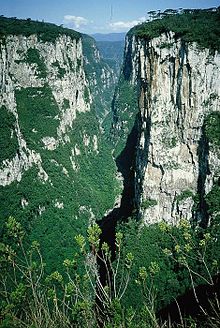
Several ecoregions cover portions of the state. In the northeastern corner of the state, between the Serra do Mar/Serra Geral and the Atlantic, lies the southern extension of the Serra do Mar coastal forests, a belt of evergreen tropical moist forests that extend north along the coastal strip as far as Rio de Janeiro state. The high plateau behind the Serra do Mar is occupied by the Araucaria moist forests, a subtropical forests characterized by evergreen, laurel-leaved forests interspersed with emergent Brazilian Pines (Araucaria angustifolia). The Paraná-Paraíba interior forests lie on the lower slopes of the plateau south and east of the Araucaria forests, including much of the lower basin of the Jacuí and its tributaries. These forests are semi-deciduous, with many trees losing their leaves in the summer dry season. The Atlantic Coast restingas, distinctive forests which grow on nutrient-poor coastal dunes, extend along the coast, as far as the Uruguayan border.
The southern and eastern portion of the state is covered by the Uruguayan savanna, which extends south into Uruguay.
History
Despite being mainly rural for much of its early history, Rio Grande do Sul's prairies have been the scene of bloody wars: the dispute between Portugal and Spain for the Sacramento Colony, the Guarani Missions War, the Federalist Revolution, the Maurers Revolt and the Vargas's levant.
It also was a focal point for internal rebellion in the 19th century.

In 1835 a separatist movement broke out in the province and lasted ten years. It was eventually eliminated through the use of money and favors than by force of arms; but the province suffered in the struggle and did not recover for many years. It is of interest that Giuseppe Garibaldi joined the separatists for a while before he moved on and eventually became a hero in his native Italy. In 1865 a Paraguayan army invaded the state and on 5 August occupied the town of Uruguaiana. In the following year in September, however, the Paraguayan General Estigarribia surrendered without a fight - an unusual occurrence in the War of the Triple Alliance.
Political agitations were frequent in Rio Grande do Sul, but no important revolution occurred after the Ponche Verde Treaty in 1845 until the presidency at Rio de Janeiro of General Floriano Peixoto, whose ill-considered interference with the state governments led to the revolt of 1892-94, under Gumersindo Saraiva.
In this struggle the revolutionists occupied Santa Catarina and Paraná, capturing Curitiba, but were eventually overthrown through their inability to obtain munitions of war. An incident in this struggle was the death of Admiral Saldanha da Gama, one of the most brilliant officers of the Brazilian navy and one of the chiefs of the naval revolt of 1893-94, who was killed in a skirmish on the Uruguayan border towards the end of the conflict.
In 1738 the territory (which included the present state of Santa Catarina) became the Capitania d'el Rei and was made a dependency of Rio de Janeiro. Territorial disputes between Spain and Portugal led to the occupation by the Spanish of the town of Rio Grande (then the capital of the capitania) and neighbouring districts from 1763 to 1776, when they reverted to the Portuguese. The capture of Rio Grande in 1763 caused the removal of the seat of government to Viamão at the head of Lagoa dos Patos; in 1773 Porto dos Cazaes, renamed Porto Alegre, became the capital. In 1801 news of war between Spain and Portugal led the inhabitants of Rio Grande to attack and capture the seven missions and some frontier posts held by the Spaniards since 1763; since 1801 the boundary lines established by treaty in 1777 have remained unchanged.
The districts of Santa Catarina and Rio Grande had been separated in 1760 for military convenience, and in 1807 the latter was elevated to the category of a capitania-geral, with the designation of "Sao Pedro do Rio Grande," independent of Rio de Janeiro, and with Santa Catarina as a dependency. In 1812 Rio Grande and Santa Catarina were organized into two distinct comarcas, the latter becoming an independent province in 1822 when the Empire of Brazil was organized.
In the far western area of the state are the remnants of Brazil's 17th century Jesuit missions or reductions (aldeias) to the Guaraní Indians. Important to the region, it should be noted that Jesuit Father Roque Gonzales, also known as Roque Gonzales de Santa Cruz, who arrived from Paraguay on the 3rd of May of 1626 to establish the Saint Nicolas mission (today known as São Nicolau), was the first white person to enter in what is today know as the state of Rio Grande do Sul. Of all the ruins left behind by the vanished Guarani Missions, the most significant one is São Miguel or São Miguel Arcanjo, located nearby the present city of Santo Ângelo. There is an ongoing Light and Sound (or Som e Luz in Portuguese) show presented at the ruins of the São Miguel church. Originally part of Uruguayan territory it was lost in the Uruguayan struggle for independence. Uruguay could have lost all of the Rio Grande do Sul area if not for the help of Argentina, which wanted to defeat Brazil.
Getulio Vargas, who led Brazil as dictator from 1930 and later was elected president in 1950, was a native of Rio Grande do Sul.
1992 saw a unilateral declaration of independence by The Movement for the Independence of the Pampas, calling for a referendum on the establishment of a state based on the borders of the former Riograndense Republic
Demographics
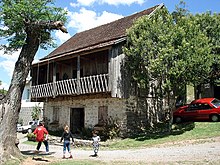
According to the IBGE of 2006, there were 10.854.343 people residing in the state. The population density was 38,49 inh./km². The last PNAD (National Research for Sample of Domiciles) census revealed the following numbers: 9.128.502 million White people (84.1%), 1.128.851 million Pardo (Brown) people (10.4%), 564 thousand Black people (5.2%), 10 thousand Asian or Amerindian people (0.4%).[3]
The majority of the Whites of the state is of Italian, Portuguese and German descent. The Pardos are a mixture of Europeans with the Blacks and Amerindians, varying of clear to dark, being able to have a yellowish or brown skin. The Blacks are of African descent.
Source: PNAD.
Rio Grande do Sul's population consists primarily of the descendants of European immigrants, mainly Portuguese, Italians, and Germans and, to a much smaller extent, groups of Afro-Brazilians, Poles, Spanish, Russians, Lithuanians, Ukrainians and Jews.
The first German immigrant families arrived in Rio Grande do Sul in 1824 at the town of São Leopoldo, and within the next one hundred years an estimated quarter of a million Germans settled in Brazil, mostly in Rio Grande do Sul and the neighboring state of Santa Catarina.
Most of the German speakers in southern Brazil spoke or eventually adopted the Hunsrückisch dialect so that it became the most commonly used German dialect in this part of the world and is still spoken by millions today (also referred to as Riograndenser Hunsrückisch to differentiate it from the Hunsrückisch spoken in Germany).
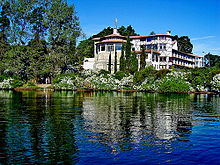
In its 180 years of history Riograndenser Hunsrückisch has been greatly influenced by other German dialects (such as Pomeranian, Pfälzisch) and by immigrant languages such as the national language, Portuguese but also to some degree by Italian.
Talian is a uniquely Brazilian variety of Italian not spoken anywhere else in the world. The emergence of Talian in Rio Grande do Sul happened because of the great variety of Italian dialects that came together into a fairly compact and specific geographical location of the state. Talian is frequently called Vêneto because it is close to the Venetian language spoken in Italy's Veneto region.
Italian immigrants began arriving in the area in the late 1800s, settling mostly in the hilly Northeastern parts of Rio Grande do Sul. Soon the region became the most important grape and wine-producing region in Brazil. Although the climate does not favor the production of the finest wines, the last few years have seen great progress in winemaking, especially with white sparkling wines.
All minority languages in southern Brazil have experienced a significant degree of decline in the last few decades, not only immigrant languages such as Italian or Talian and German, but also the indigenous languages of the Kaingang (also spelled Kaingáng, Cainguangue, etc.) and the Guaraní.
Rio Grande do Sul's demographics History
The region what is now Rio Grande do Sul was originally settled by Amerindian peoples, mostly Guarani and Kaingangs[4]. European settlement started in 1627 with Spanish Jesuits. Portuguese Jesuits established Indian Reductions in 1687 and dominated the region. Most of the Indians of the region became Catholics and went to live among the Jesuits. These reductions were destroyed by the Bandeirantes from São Paulo in the 18th century, who wanted to enslave the Indians.

The Portuguese settlement in Rio Grande do Sul was largely increased between 1748 and 1756, with the arrival of two thousand immigrants from the Azores Islands, Portugal. They settled many parts of the state, including the nowadays capital, Porto Alegre.
Blacks were 50% of Rio Grande do Sul's population in 1822. This number decreased to 25% in 1858 and to only 5.2% in 2005. Most of them came from Angola to work as slaves in the cattle farms. Nowadays, the Black community is mostly concentrated in the Porto Alegre region.[5]
German immigrants first arrived to Southern Brazil in 1824. They were attracted to Brazil to protect the country from invasions of the neighboring countries and to populate the empty interior of the Southern region. The first city to be settled by them was São Leopoldo. In the next five decades, other 28 thousand Germans were brought to the region to work as small farmers in the countryside.[6]
Italian immigrants started arriving in Rio Grande do Sul in 1875. They were mostly poor peasants from Veneto, Northern Italy, who were attracted to Southern Brazil to get their own lands. Italian immigration to the region lasted until 1914, with a total of 100 thousand Italians settling there in this period. Most of the immigrants worked as small farmers, mainly cultivating grapes in the Serra Gaúcha part of the state.[7]
Other European immigrants also migrated to Rio Grande do Sul, mostly coming from Eastern Europe (Poland, Ukraine and Russia).
Economy

One of the most prosperous Brazilian states, Rio Grande do Sul is known especially for grain production, viticulture, ranching, and for its considerable industrial output. Constituting less than 6% of the total Brazilian population, the state accounts for nearly 10% of the Brazilian GDP. The main products exported by Rio Grande do Sul are shoes, tobacco, automobiles, grains, beef, leather, and chemicals. Natives of the state are known as Gaúchos, named after the cattle herders and ranchers who settled the state's pampa regions.
Education
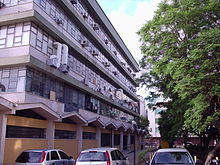

Portuguese language is the official language of schools. English language and Spanish language are part of the official high school curriculum.
Colleges and universities
- Universidade Federal do Rio Grande do Sul (UFRGS);
- Universidade Estadual do Rio Grande do Sul (UERGS);
- Fundação Universidade Federal do Rio Grande (FURG);
- Fundação Faculdade Federal de Ciências Médicas de Porto Alegre (FFFCMPA);
- Universidade Federal de Pelotas (UFPel);
- Universidade Católica de Pelotas (UCPel);
- Universidade Federal de Santa Maria (UFSM);
- Universidade Federal do Pampa (UNIPAMPA);
- Pontifícia Universidade Católica do RGS (PUC-RGS);
- Universidade do Vale do Rio dos Sinos (UNISINOS);
- Universidade Luterana do Brasil (ULBRA);
- Universidade de Santa Cruz do Sul (UNISC);
- and many others.
Infrastructure
International airport


With 37.6 thousand square meters of constructed area and four levels, the passenger terminal at Porto Alegre International Airport can receive 28 large airplanes simultaneously. The terminal has 32 check-in counters, ten boarding bridges, nine elevators and ten escalators. It has a totally automated aircraft movement control center and the main spaces are air conditioned. The apron, surfaced with prestressed concrete, can serve jumbo jets like the Boeing 747-400. The garage structure has eight levels, 44 thousand square meters and 1,440 parking spaces. Another terminal, with 15 thousand square meters and capacity for 1.5 million passengers a year, serves general, executive and third-tier aviation (conventional piston-engine and turboprop planes). Porto Alegre Airport was the first one administered by Infraero to have integrated check-in. This service offers flexibility in use of terminal facilities and installations, enabling carriers to access their own data centers via shared-use computers from any check-in counter position. This makes it much easier to allocate counter space according to demand fluctuations, making for less idle space. The Aeroshopping area – a center for commerce and leisure – operates 24 hours a day with shops, services, a food court, along with a triplex cinema, the first to be established at a Brazilian airport. Salgado Filho International Airport also has an air cargo terminal, built in 1974, with 9,500 thousand square meters of area and capacity to handle 1,500 tons of export cargo and 900 tons of imports each month. The average daily movement (arrivals and departures) is 174 aircraft, flying scheduled routes connecting Porto Alegre directly or indirectly to all the country’s other major cities, as well as smaller cities in the interior of the states of the South Region and São Paulo. There are also international flights with direct connections to cities of the Southern Cone.
Kraemer International Airport opened on July 5, 1946, this airport came under Infraero administration on October 27, 1980. It is located in the rural zone of Bagé, 60 km from the Uruguayan border and 380 km from Porto Alegre. Comandante Gustavo Kraemer International Airport does not operate with scheduled commercial flights. There are two daily flights carrying bank pouches, as well as air taxi services and executive jets. Most of the airport’s users are businesspeople from the central part of Brazil who have interests in the region in breeding thoroughbred English and Arabian horses, cattle ranching, fruit growing, wine making, wood pulp and power generation.
Located on the border with Argentina (at Paso de los Libres), Uruguaiana is considered the major inland port in Latin America, thanks to its strategic position with the countries of Mercosur. Rubem Berta International Airport, however, does not operate any scheduled regional flights – a situation Infraero intends to change, as was confirmed in an official visit to the airport in December 2004. With more than 700 thousand square meters of constructed area, it is the largest airport in the interior of the state of Rio Grande do Sul. There are two highways, BR-290 and BR-472, running near the airport, besides a railroad line about 2,500 meters from the terminal. Located 9 km from the center city, this airport is at an elevation of 78 meters and the average annual temperature is 16°C, with a good deal of variation from summer to winter. Located 630 km from the state capital (Porto Alegre), Uruguaiana was founded on May 29, 1746, and has a current population of 126,936. Farming and ranching are the main economic activities of the region, which has 1509 rural properties.
Culture
This article contains wording that promotes the subject in a subjective manner without imparting real information. |


The state of Rio Grande do Sul is renowned as one of the most culturally rich states of Brazil. Rio Grande's music is a blend of many styles (Prata's Rhythms in the main), including the Chamamé, Milonga, Polca and Chacarera. The inhabitants of the state are famous in the country for drinking chimarrão, a local version of the mate drunk in neighbouring Uruguay and Argentina. Barbecue locally known as "churrasco" is one of the most important elements the culture. Rio Grande do Sul's culture is far from a typical Brazilian one. Fashion plays a prominent role in Rio Grande do Sul, by far the largest provider of top models and misses in Brazil - Misses Rio Grande do Sul have won 5 of the last 10 editions -, Alessandra Ambrosio, Gisele Bündchen, Ana Hickmann, Letícia Birkheuer are some of the international super models from Rio Grande do Sul. The Riograndenses are assiduous readers. The state has the highest proportion of books read per capita in Brazil, with Latin America's largest outdoor book fair, the Porto Alegre Book Fair, taking place in Porto Alegre every year.
In commemoration of the War of Tatters, Farroupilha Week takes place between the 13th and the 20th of September every year. Musical and dancing shows from the Pampas region, typical foods, and a traditionalist parade.
In common with other states in Brasil, a Carnival also takes place in the run-up to Lent.
Minority Languages
Minority languages spoken in Rio Grande do Sul can be divided into two groups: Indigenous languages (Guarani, Caingangue, etc.) and European derived Languages (German, Venetian/Italian, Riograndenser Hunsrückisch (a German dialect) and Pomeranian Low German (Low Saxon), Polish and other Slavic languages).
Tourism

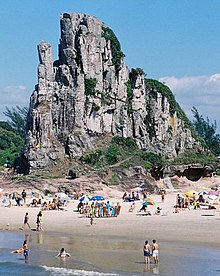
Ecotourism is very popular in the Germanesque cities of Gramado and Canela; their cold weather is among their attractions for internal tourism. Tourism is also high in the wine regions of the state, principally Caxias do Sul and Bento Gonçalves. The pampas of the native Brazilian gaúcho are both a national and international curiosity to tourists and their customs are alive in the capital city of Porto Alegre as well as in the cities of the "interior" or western Rio Grande do Sul such as Santa Maria and Passo Fundo. The state is also home to the historic São Miguel das Missões, the ruins of an 18th century Jesuit Mission. In the city of Nova Prata, in way the native bush, you find a park thematic, with sources that gush out thermal waters in a temperature of 41°C, which possess excellent medicinal properties and therapeutical.
The state of Rio Grande do Sul and its cities have developed a series scenic routes to appeal to tourists. The Rota Romântica is a popular scenic drive that exhibits the diverse Germanic culture of the mountainous regions of the state referred to as the Serra Gaúcha. One can visit the state's Italian settlements through Caminhos da Colônia, tour the wine country through the Rota da Uva e do Vinho and visit a subsection of the Rota Romântica called the Região das Hortênsias, the region filled with beautiful blue hydrangea flowers each spring.
Main Towns

Porto Alegre (the state's capital city), Caxias do Sul, Pelotas, Canoas, Santa Maria, São Leopoldo, Novo Hamburgo, Rio Grande, Passo Fundo, Osório, Santa Cruz do Sul, Erechim, Gravataí, Bento Gonçalves, Nova Prata, Uruguaiana, Livramento, Gramado, Igrejinha, Nova Petropolis, Canela and Bagé.
See also:
Same Sex Civil Union
The only Brazilian state to have done so as of 2007, Rio Grande do Sul legalised civil unions after a court decision in February 2005.[8] Same-sex couples in committed relationships can register at any notary public office. It does not affect federal rights but it gives same-sex couples more equality in many areas e.g. a alien gay partner may now receive immigration papers based on the relationship. Same-sex couples who register have the right to jointly own property, establish custody of children, and claim the right to pensions and property when one partner dies.
References
- ^ The presented pronunciation is in Brazilian Portuguese variant spoken in Rio Grande do Sul. Other prossible pronunciations in Brazil are: IPA: [xiu 'gɾɐ̃.dʒi du suw] (Rio de Janeiro), IPA: [ʁiu 'gɾɐ̃.dzi du suw] (São Paulo) and IPA: [xiu 'gɾɐ̃.di du su] (Northeast). The European Portuguese pronunciation is: /ʁiw 'gɾɐ̃.ð(ɨ) du suɫ/.
- ^ IPEADATA (in Portuguese)
- ^ Demographics
- ^ http://www.paginadogaucho.com.br/indi/grupo.htm
- ^ http://www.riogrande.com.br/historia/colonizacao6.htm
- ^ http://www.mre.gov.br/CDBRASIL/ITAMARATY/WEB/ingles/consnac/imigra/alemaes/index.htm
- ^ http://www.mre.gov.br/CDBRASIL/ITAMARATY/WEB/ingles/consnac/imigra/italiano/index.htm
- ^ Tribunal de Justiça, "Decisão dá base legal para casamento entre pessoas do mesmo sexo"
This article incorporates text from a publication now in the public domain: Chisholm, Hugh, ed. (1911). Encyclopædia Britannica (11th ed.). Cambridge University Press. {{cite encyclopedia}}: Missing or empty |title= (help)
